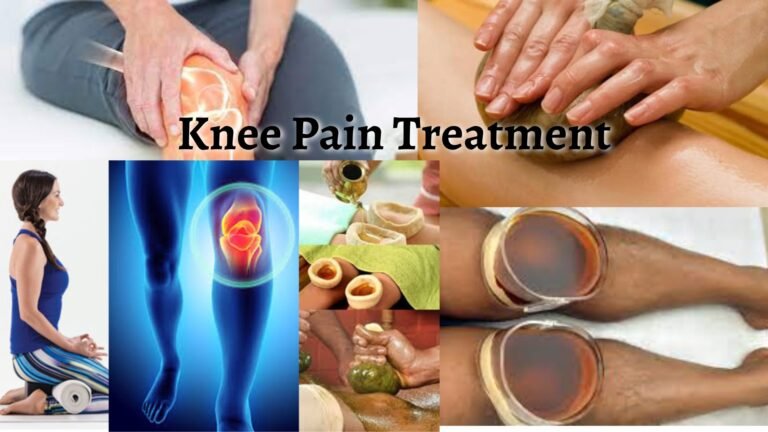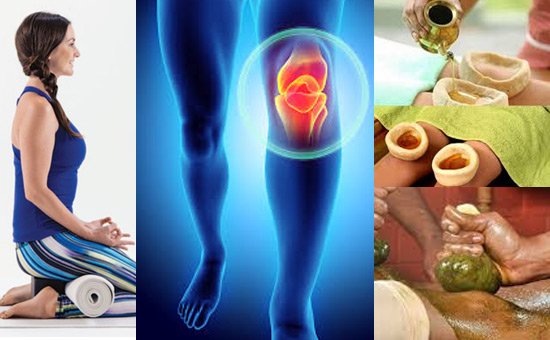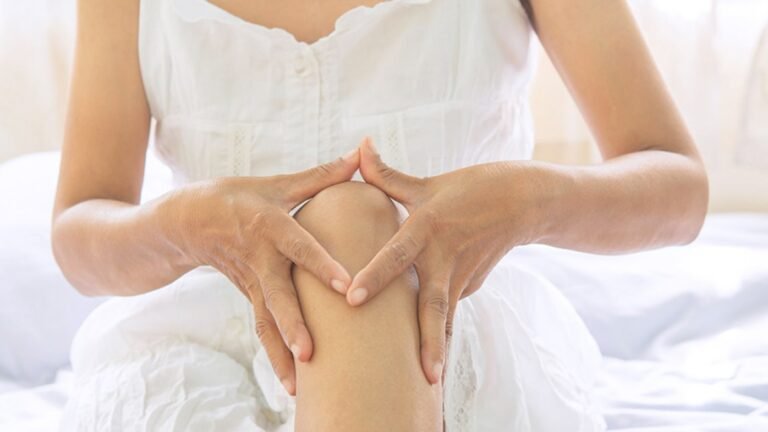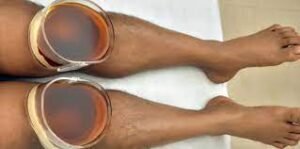Are you tired of knee pain holding you back from enjoying your daily activities? It’s time to kick knee pain to the curb, the natural way! Ayurveda, the ancient Indian healing system, offers many holistic remedies that can help you conquer knee pain and regain your freedom of movement. Step into the world of wisdom and discover how you can restore balance and harmony to your body, mind and spirit.
In this blog post, we’ll explore the Ayurvedic perspective on knee pain, powerful herbs and remedies, rejuvenating therapies and lifestyle tips that will empower you to live a pain-free life. Get ready to embrace a new era of knee health and say hello to your most vibrant self!

What is Knee Pain?
Knee pain is a common issue experienced by people of all ages and activity levels, often resulting from injuries, overuse, or age-related wear and tear. It can cause discomfort, limit mobility and negatively impact one’s quality of life. With an increasing number of individuals facing knee pain, the search for safe, effective and natural remedies has never been more crucial.
Ayurvedic Perspective on Knee Pain
In Ayurveda, the concept of Doshas – Vata, Pitta, and Kapha – plays a central role in understanding and addressing knee pain. These three Doshas represent the fundamental energies governing our physiology, with each Dosha responsible for specific bodily functions. When it comes to knee pain, Vata is often the primary Dosha involved. Vata, responsible for movement and circulation, can become imbalanced due to factors such as age, lifestyle, and diet. An imbalance in Vata can lead to joint stiffness, dryness, and inflammation, which in turn contribute to knee pain.


Causes of Knee Pain
Knee pain can result from various factors, including injuries, medical conditions, and lifestyle habits. Some key causes of knee pain include:
• Injuries -
Acute injuries to the knee, such as ligament tears (ACL, MCL, or PCL), meniscus tears, fractures, or tendon injuries (e.g., patellar tendinitis), can cause significant pain and discomfort.
• Overuse injuries -
Repetitive stress on the knee joint, often seen in athletes or individuals with physically demanding occupations, can lead to conditions such as iliotibial band syndrome, patellofemoral pain syndrome, or bursitis.
• Gout -
A form of arthritis caused by a build-up of uric acid crystals in the joints, gout can lead to sudden and severe knee pain.
• Infections -
In rare cases, infections like septic arthritis can cause knee pain and require immediate medical attention.
• Muscle imbalances and weakness -
Weak or imbalanced muscles surrounding the knee can cause undue stress on the joint, leading to pain and instability.
• Osteoarthritis -
This age-related wear and tear of the joint cartilage is a common cause of knee pain, particularly in older adults.
• Rheumatoid arthritis -
An autoimmune disorder that causes inflammation in the joints, rheumatoid arthritis can result in chronic knee pain and stiffness.
• Mechanical issues -
Problems such as a dislocated kneecap, loose cartilage, or a Baker’s cyst (fluid-filled cyst behind the knee) can lead to knee pain.
• Obesity -
Carrying excess body weight puts additional stress on the knee joints, increasing the risk of pain and joint damage.
• Poor posture and alignment -
Improper posture or biomechanics during physical activities can contribute to knee pain over time.



Signs and Symptoms of Knee Pain
Knee pain can manifest in various ways, depending on the underlying cause and severity of the condition. Some key signs and symptoms of knee pain include:
• Pain -
The pain can be dull, sharp, aching, or throbbing, and its intensity may vary from mild to severe.
• Swelling -
Inflammation or fluid build-up in the knee joint can cause visible swelling and tenderness around the affected area.
• Instability or weakness -
A sensation of the knee giving out or buckling under pressure may indicate ligament or muscle issues.
• Crepitus -
A grinding or crunching sensation when moving the knee can be a sign of cartilage damage or arthritis.
• Deformity -
In more severe cases, a visible deformity or misalignment of the knee joint may be present.
• Stiffness -
Limited range of motion or difficulty bending or straightening the knee can indicate joint stiffness.
• Redness and warmth -
An inflamed or infected knee joint may appear red and feel warm to the touch.
• Locking or catching -
The knee may feel like it’s locking or catching during movement, which can be a symptom of a meniscus tear or loose cartilage.
• Bruising -
Visible bruising around the knee may result from an injury or trauma to the joint.
• Reduced mobility -
Difficulty walking, climbing stairs, or participating in regular activities due to knee pain can indicate a more serious issue.Bottom of Form
Home Remedies for Knee Pain
Ayurveda offers many effective home remedies to control knee pain. They are as follows:
• Warm oil massage -
Gently massaging the affected knee with warm sesame or mustard oil can help improve circulation and reduce pain and stiffness.
• Epsom salt soak -
Dissolve Epsom salt in a warm water bath and soak the affected knee to reduce inflammation and alleviate pain.
• Cold and hot compresses -
Alternating between cold and hot compresses on the knee can help reduce swelling, pain, and inflammation.
• Ajwain (Carom seeds) poultice -
Roast some carom seeds, wrap them in a cloth, and apply the warm poultice to the affected knee for relief from pain and swelling.
• Fenugreek seeds -
Soak fenugreek seeds overnight in water and consume them the next morning to help reduce joint pain and inflammation.
• Ginger tea -
Drinking ginger tea or applying a ginger paste to the affected knee can help relieve pain and inflammation due to its anti-inflammatory properties.
• Dried ginger and turmeric paste -
Mix equal parts of dried ginger and turmeric powder with water to form a paste, and apply it to the affected knee for pain relief.
• Yoga and stretching exercises -
Regularly practicing gentle knee stretches and yoga poses targeting the knee joint can ease knee pain.
Ayurvedic Lifestyle Tips for Preventing Knee Pain
An essential aspect of conquering knee pain is not only addressing existing discomfort but also taking proactive steps to prevent future issues. Ayurveda offers valuable lifestyle tips that can help you maintain healthy knees and support overall well-being:
• Incorporating a balanced diet -
A nourishing, balanced diet is vital for maintaining healthy joints. Include foods rich in anti-inflammatory properties, such as ginger, turmeric, and omega-3 fatty acids, as well as calcium and vitamin D for strong bones. Avoid foods that can aggravate Vata, such as cold and dry foods, and opt for warm, cooked meals instead.
• Regular exercise and yoga practice -
Engaging in regular, low-impact exercise helps strengthen the muscles surrounding the knee joint, providing stability and support. Incorporate yoga poses that target the knee, such as gentle stretches and strengthening exercises, to maintain flexibility and joint health.
• Maintaining a healthy body weight -
Excess body weight puts additional strain on your knee joints, increasing the risk of pain and joint damage. Adopting a healthy lifestyle with a balanced diet and regular physical activity can help you maintain an optimal weight and reduce pressure on your knees.
• Adequate sleep and stress management -
Adequate sleep is crucial for the body’s repair processes, including the health of your joints. Aim for 7-8 hours of restful sleep per night and incorporate stress management techniques like meditation and deep breathing exercises to support overall wellness and prevent knee pain.



Ayurvedic Treatments for Knee Pain
Ayurveda has several effective therapies that can cure knee pain. Here are some of these therapies:
Abhyanga (Ayurvedic oil massage) -
Abhyanga is a traditional Ayurvedic oil massage that involves the application of warm, medicated oil to the entire body, including the affected knee. This soothing massage technique helps improve blood circulation, reduces joint stiffness, and promotes overall relaxation. Abhyanga can be particularly beneficial for those experiencing knee pain due to Vata imbalance, as the warm oil helps to nourish and lubricate the joint, easing pain and improving mobility.
Janu Basti (Medicated oil treatment for the knee) -
Janu Basti is a specialized Ayurvedic therapy that focuses on the knee joint. In this treatment, a dough ring is created around the affected knee, and warm, medicated oil is poured inside, allowing the knee to soak in the oil for a specific period. The oil is then replaced to maintain a consistent temperature. Janu Basti helps to alleviate knee pain, reduce inflammation and improve joint flexibility by providing deep nourishment and lubrication to the knee joint.
Pinda Sweda (Herbal poultice therapy)
Pinda Sweda is an Ayurvedic therapy that involves the use of warm, herbal poultices to massage and treat the affected knee. The poultices, typically made from a blend of herbs, grains, and medicated oils, are heated and applied to the knee to provide relief from pain, stiffness, and inflammation. The combination of heat and herbal ingredients in Pinda Sweda promotes healing, improves circulation, and aids in the detoxification process, providing lasting relief from knee pain.
Kati Basti (Localized oil therapy for the lower back)
While Kati Basti primarily targets the lower back, it can also provide relief for knee pain, as the therapy helps to address any underlying imbalances that may contribute to joint pain throughout the body.
In Kati Basti, a dough ring is placed around the lower back, and warm, medicated oil is poured inside. This localized treatment helps to nourish and strengthen the surrounding muscles and tissues, alleviate pain, and restore balance in the body. By addressing any imbalances in the lower back, Kati Basti can indirectly support knee pain management and improve overall joint health.
Important Takeaway
Ayurveda offers a comprehensive approach to conquering knee pain naturally by addressing the root causes of discomfort and promoting overall wellness. By understanding the Ayurvedic perspective on knee pain and adopting a holistic approach that includes powerful herbs, rejuvenating therapies and essential lifestyle tips, you can regain control of your knee health and rediscover the freedom of pain-free movement.
As you explore the world of Ayurveda, remember that the key to success lies in restoring balance and harmony within your body, mind and spirit. So, are you ready to embark on a journey towards a more vibrant, pain-free life?

One Response
Superb